Use 'Print preview' to check the number of pages and printer settings.
Print functionality varies between browsers.
Printable page generated Monday, 10 November 2025, 9:24 PM
Study Session 3 Development of the OWNP
Introduction
The One WASH National Programme (OWNP) came into existence through a long process. The Programme is a result of a concerted effort by the Ethiopian government and its partners working in the sector. In the first two study sessions you have learned about the challenges that faced the WASH sector and about some of the policies, strategies and programmes that were developed in the 1990s and early 2000s and had begun to bring some improvements. These were the early stages of the process that led to the development of the OWNP. By the mid-2000s, the importance of cross-sector collaboration was increasingly being recognised and discussions were beginning about a new approach.
In this study session, you will learn about the main initiatives in both national and international arenas that have shaped the Programme in terms of its content, structure and implementation. You will be introduced to the major Programme implementation mechanisms and working documents, and therefore become acquainted with the evolution of the OWNP.
Learning Outcomes for Study Session 3
When you have studied this session, you should be able to:
3.1 Define and use correctly all of the key words printed in bold. (SAQs 3.1 and 3.3)
3.2 Explain how the OWNP emerged as a national plan. (SAQ 3.2)
3.3 Identify and describe the main documents that preceded the OWNP. (SAQ 3.3)
3.4 Summarise how national and international initiatives guided the OWNP’s development. (SAQ 3.4)
3.1 Sector-wide approach
As you may have noticed, in every walk of life the need to look for better ways of doing things never stops. We always learn from past experiences and, based on the lessons learned, we change our way of doing a particular task in order to yield better results. We can also expect that the new way of doing things will be cost-effective and shorten the time it takes to accomplish.
In the WASH sector, for many decades, a project-based aid approach, sometimes referred as ‘the traditional aid approach’, was applied at all levels. A project-based aid approach means aid is provided to support the implementation of a single project without integrated planning or use of resources. In the past, for instance, donors used to support either water supply, sanitation or hygiene education projects separately, one at a time, each funded by a single donor. The need to pool resources and integrate projects was not well recognised. However, when the project-based approach was evaluated, it was found to be inefficient in terms of resource use, and tended not to produce the expected results for donors and recipient governments. Consequently, a new sector-wide approach has been developed and is currently being applied in various development programmes – including the WASH sector.
A sector-wide approach, sometimes shortened to SWAp, is a development concept where all significant sector investments are channelled towards the same objectives and follow a consistent strategy that is guided by a consolidated investment plan. In the early 1990s, SWAp became popular as several donors recognised the comparative advantages it brought in maximising the effectiveness and efficiency of aid.
SWAp is based on a framework where all resources in a sector are managed in an integrated and harmonised manner. In addition to being more effective and efficient, SWAp can create the opportunity for aid-recipient governments to play the leading role, with all funds being disbursed and managed by the government.
The need to shift towards a sector-wide approach is supported by evidence from many WASH projects in the past which were unsatisfactory in terms of result, sustainability or empowerment of beneficiaries. For example, several years ago a project team was trying to promote latrine construction at household level. They provided latrine construction materials to households for free, including corrugated iron sheet for roofing, concrete rings for pit lining and concrete squatting slabs. However, no effort was made to create demand for latrine construction in the target communities; the team did not consider hygiene education to be part of the project. After a while, when the team visited households to monitor progress they found that, rather than constructing latrines, the families had used the materials provided for other purposes. Corrugated iron sheets had been used for making doors, the concrete rings were used to make grain store pits and the slabs were used to cover these pits. Experiences like this meant that the need to consider and involve all sectors, at all stages of a programme, was gradually recognised and became standard procedure.
The main differences between the two approaches are summarised in Table 3.1. Some of the terms used in the table are defined in the notes below it.
| Parameters | Sector-wide approach | Single-sector (traditional) approach |
|---|---|---|
| Efficiency¹ | Maximised | Decreased |
| Equity² | Ensured | Compromised |
| Transaction costs³ | Minimised | Increased |
| Sustainability4 | Certain | Uncertain |
| Resource management | Integrated and coherent | Fragmented and incoherent |
| Government ownership and leadership | Improved | Weakened |
1 Efficiency: increasing output for a given input, or minimising input for a given output, while still maintaining quality.
2 Equity: allocation of resources, services and opportunity to all segments of the population according to their needs, for example, all regions, agrarian and pastoralist, urban and rural, able and disabled, male and female, etc. In other words, equity means fairness and impartiality to all concerned.
3 Transaction costs: costs incurred in making an economic exchange.
4 Sustainability:generally refers to projects and interventions that give due consideration to social, cultural, and environmental factors, as well as the economic factors, and therefore are more effective and long-lasting.
Compared with the traditional approach, what are the benefits of a sector-wide approach in the WASH sector?
The sector-wide approach means that resources are consolidated and managed in an integrated and harmonised manner. It can bring improved efficiency, equity and sustainability of development projects. In addition, it ensures government ownership and enables them to play a leading role.
The sector-wide approach marked a shift of development thinking from single-sector into multi-sector perspectives. Accordingly, this concept of engaging all relevant sectors with a clear outline of the roles and responsibilities within each of the sectors has been well recognised and practically applied in the One WASH National Programme.
3.2 Memorandum of Understanding
Merely understanding and wanting to apply a sector-wide approach is not enough. To put wishes into action there needs to be a formal and legally binding agreement between the stakeholder organisations. (A stakeholder can be defined as an individual, organisation or institution with an interest in an enterprise, project or programme.) As a means to materialise the sector-wide approach for WASH, the stakeholder ministries had to agree on how to share roles and responsibilities. This led to the development of a Memorandum of Understanding. A Memorandum of Understanding, commonly abbreviated to MoU, is a formal working document that outlines the procedures and roles, responsibilities and accountability of the organisations that sign it towards meeting a specified objective.
Do you recall from Study Session 1, which ministries were involved in developing the OWNP?
The government ministries that are stakeholders in the OWNP are: the Ministry of Water, Irrigation and Energy; the Ministry of Health; the Ministry of Education and the Ministry of Finance and Economic Development. (You may also have remembered the Ministry of Water Resources from Study Session 2. This is the former name of the Ministry of Water and Energy, which was later renamed the Ministry of Water, Irrigation and Energy, and, in 2015, became the Ministry of Water, Irrigation and Electricity.)
Figure 3.1 shows the Memorandum of Understanding being signed by representatives of the Ministries of Water, Health, and Education in 2006.
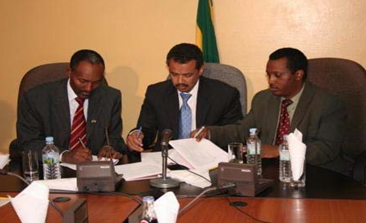
Following the signing in 2006, it was realised that the MoU had some gaps that were hampering the WASH promotion efforts. The main gap identified was the fact that the Ministry of Finance and Economic Development (MoFED) was not included as a signatory. All WASH projects and programmes needed to mobilise and manage funds, therefore it was essential to involve MoFED.
In addition to this, the original MoU did not include any mention of accountability. Accountability is an obligation or willingness to accept responsibility. Each of the WASH signatory ministries needed to be accountable for their activities to ensure they were fully addressing their respective roles and responsibilities as detailed in the MoU. Therefore, after about six years, in November 2012, a revised MoU was signed by four ministries: the Ministry of Water and Energy (MoWE); the Ministry of Health (MoH); the Ministry of Education (MoE), all of whom had all signed the first MoU, and the Ministry of Finance and Economic Development (MoFED).
The two main features of the revised (second) MoU were:
- MoFED, which has an essential role to play in managing WASH funds, became the fourth signatory.
- It has a dedicated section on accountability, which is crucial to check on the fulfilment of the roles and responsibilities of each of the signatory ministries.
The MoU signed by the respective ministers has been further cascaded down to all Regional States where it has been signed by heads of the respective regional bureaus, i.e., Health, Education, Water, Irrigation and Energy, and Finance and Economic Development.
The National WASH MoU that was revised and signed in November 2012 was an essential preliminary step in the development of the OWNP itself. The MoU has eight sections, which can be summarised as follows:
Introduction
This provides overall background information on the national WASH endeavour. Commitments of the Ethiopian government to achieve WASH-related targets set at both national and international level under the Millennium Development Goals are highlighted. The Introduction sets out the government’s intention to uplift the country’s economy to the level of middle-income countries by the year 2025. Associated with this aim is the need to work hard towards improving social services such as WASH. Progress and impact in WASH service delivery is described as hampered by the fragmented and uncoordinated efforts of different ministries.
The Introduction section concludes by underlining the purpose of the revised MoU: ‘to ensure the effective achievement of WASH targets set in the Growth and Transformation Plan’ (MoWE et al., 2012).
Rationale for the revision of the former MoU
A number of reasons for revising the 2006 MoU are mentioned. For example, new developments at national and international levels, reform of organisational structures and a change in the system for channelling funds by the major donors that had enhanced the role of MoFED. Also mentioned are the Urban Health Extension Programme and the growing need for the private sector to involve itself in WASH provision.
Rationale for integration of water, sanitation and hygiene
Under this section the benefits of providing WASH services as a package are described. This section also clearly indicates the shift from a project-based to a sector-wide approach, which paved the way for the development of the OWNP later in 2013.
Major areas of co-operation
Among others, the following areas of co-operation are listed:
- consideration of the principle of ‘one plan, one budget, one report’ in order to jointly prepare WASH ‘plans of action’
- joint monitoring and evaluation of WASH programme implementation
- to establish strong links with all WASH partners, including civil society organisations (CSOs) and the private sector.
Administrative and technical arrangements
This section outlines the technical and administrative arrangements with specified roles and responsibilities to ensure effective and efficient WASH programme management.
Undertakings by each WASH sector ministry
This section lists expected tasks of the four signatory ministries, geared towards the national WASH programme implementation process.
Specific responsibilities of sector ministries in planning and implementing the WASH programme
The particular responsibilities assigned to each ministry are exhaustively listed under this section. It also includes the responsibilities of major non-governmental WASH partners and financing institutions.
Accountability
The last but most important part of the MoU, missed in the first MoU, contains the specific areas of accountability shared amongst signatory ministries.
3.3 WASH Implementation Framework
The WASH Implementation Framework (WIF) is a guiding document for all WASH programmes across the country and one of the key documents associated with the OWNP.
The need for a comprehensive implementation framework was justified by practical lessons learned in the past where the lack of integration did not bring good results or achieve targets. As has been noted in Study Session 1, collaboration among relevant sectors was weak. In fact, there had been some attempts to bring the sectors on board and work together, but these were usually unsuccessful. For example, some committees had been created, but with informal terms of reference which resulted in them only functioning temporarily. The absence of established mechanisms to bind them legally through clear mandates, roles, responsibilities and accountabilities remained a big obstacle to success. Taking these practical lessons into consideration, the WASH Implementation Framework was formulated and signed among the four WASH ministries on 9 August 2011 in Addis Ababa.
By that time, it had been recognised for a few years that there needed to be a thorough and detailed assessment of the current status of WASH in Ethiopia in order to measure the attainment of the intended improvements. Whether these were the challenging targets of the Universal Access Plan (98.5% of the population with access to safe water and 100% access to sanitation), or the Millennium Development Goal of halving the number without access, all cases would need baseline data for comparison. (Baseline data means information collected at the start of a project which provides a basis for comparison with later changes.) This need was met by preparing the National WASH Inventory (NWI). The NWI is an integrated record of water supply, sanitation and hygiene service coverage data, first published in 2011 and created in response to the need for reliable national WASH data. Data collection had started in 2008 and included questions about distance from a water source, the type of latrine available, and so on. Households and commercial premises in rural and urban settings were systematically surveyed by teams of trained enumerators (researchers) (Figure 3.2).
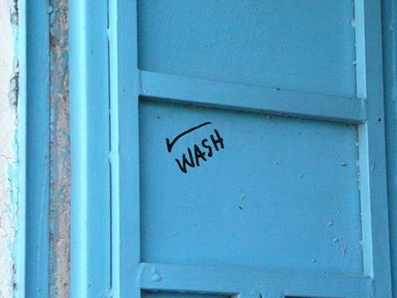
The 2011 NWI data established that, at that time, the baseline was only 52.1% and 63% access to water supply and sanitation respectively. The difference between this and the targets was huge and obviously demanded effective mechanisms to change the situation. As part of its function to describe those mechanisms, the WIF defined the roles and responsibilities of the four signatory ministries, broadly summarised as:
- Ministry of Water, Irrigation and Energy: water supply and water testing
- Ministry of Health: sanitation, hygiene, water quality monitoring and WASH in health institutions
- Ministry of Education: WASH and health clubs in schools, support to Technical and Vocational Training Colleges and Health Science Colleges
- Ministry of Finance and Economic Development: public financial management, channelling government and donor funds, and financial management and reporting.
3.4 WASH-related national initiatives
The development of the OWNP evolved through a series of processes from the late 1990s onwards. During those years, in addition to the Memorandum of Understanding and WASH Implementation Framework, various WASH-related policies, strategies and action plans were introduced by the government of Ethiopia and sector partners that were the springboard towards the development of the OWNP.
You have read about these policies, strategies and plans in Study Session 2. What were the most important ones?
Among others, the Ministry of Water introduced the National Water Resources Management Policy (1999), Water Sector Strategy (2001) and Water Sector Development Programme (2002). Similarly, the Ministry of Health had developed the National Hygiene and Sanitation Strategy (2005) and implemented the National Health Sector Development Programme. These were all aligned with national development plans such as the Growth and Transformation Plan (GTP) and the Universal Access Plan (UAP).
Another significant initiative from the Health Sector Development Programmes was the Health Extension Programme (HEP) and its innovative community-based health care delivery system. The whole philosophy of the HEP revolves around empowering communities and households to be able to foster their own health and well-being. The HEP has been dramatically accelerating the promotion of basic and primary health care, including sanitation and hygiene, especially in the rural areas of the country where the coverage of those services was very low.
The development phase for the OWNP also saw increasing recognition of the importance of protecting the environment from the negative impacts of development and safeguarding the lives and livelihoods of the population. For WASH developments, these principles form the basis of the Environmental and Social Management Framework (ESMF), which was prepared in collaboration with the World Bank. The ESMF sets out procedures to ensure that investments in WASH are implemented in an environmentally and socially sustainable manner (FDRE, 2013b).
3.5 WASH-related international initiatives
Meanwhile, the concern for WASH improvements has been growing globally (especially in low-income countries) and several initiatives in the forms of declarations, conventions, resolutions, protocols and commitments have been ratified internationally.
Which WASH-related international initiative have you already read about?
Millennium Development Goals, which set a target to halve the number of people without access to safe water and sanitation by 2015.
3.5.1 Conventions, protocols and resolutions
Over the past few decades, there have been several initiatives emanating from the United Nations (Figure 3.3), which have been enacted in terms of conventions, protocols and resolutions. These have mainly focused on ensuring people’s rights to water and sanitation and addressing the WASH needs of disadvantaged and marginalised groups of people.
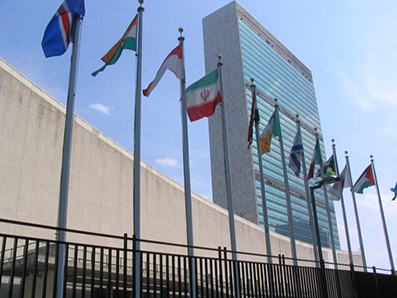
Just some of these initiatives are briefly described below:
- In 1999, a United Nations Protocol on Water and Health stated in Article 5: ‘Equitable access to water, adequate in terms both of quantity and of quality, should be provided for all members of the population, especially those who suffer a disadvantage or social exclusion’ (UN, 1999).
- In December 2003, the United Nations General Assembly, proclaimed the period 2005–2015 to be the International Decade for Action ‘Water for Life’ (Figure 3.4). It focused on co-operation at all levels and on ‘action-oriented activities and policies that ensure the long-term sustainable management of water resources, in terms of both quantity and quality, and include measures to improve sanitation’ (UNDESA, n.d.).
- In 2010, according to the Statement on the Right to Sanitation of the UN Economic and Social Council: ‘States must ensure that everyone, without discrimination, has physical and affordable access to sanitation, in all spheres of life, which is safe, hygienic, secure, socially and culturally acceptable, provides privacy and ensures dignity’ (UN, 2010).
- In 2011, the United Nations Human Rights Council adopted the resolution, The human right to safe drinking water and sanitation. This followed the UN’s 2010 recognition of the human right to safe and clean drinking water and sanitation, affirming that this is ‘derived from the right to an adequate standard of living and inextricably related to the right to the highest attainable standard of physical and mental health, as well as the right to life and human dignity’ (UN, 2011).
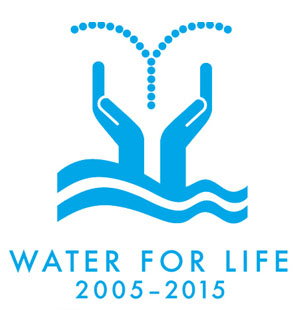
Can you identify any recurring themes in these UN initiatives?
Two themes that appear more than once are statement that access to water is a human right and that access should be equally available to all people, regardless of their differences.
3.5.2 International events
In addition to these UN resolutions, various special international events have been dedicated to WASH-related issues. They are used to create public awareness of WASH and its significant contribution to the overall economic development of a country.
Global Handwashing Day (Figure 3.5) is an annual worldwide advocacy day dedicated to increasing awareness and understanding about the importance of handwashing with soap as an easy, effective, and affordable way to prevent diseases and save lives. Celebrated annually on 15 October, Global Handwashing Day is an opportunity to encourage people to wash their hands with soap at critical times.
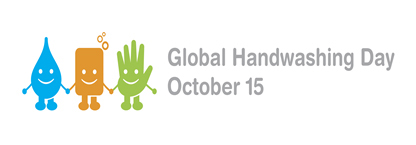
In Ethiopia, this event has been celebrated all over the country every year since 2005. In most cases, the celebration focuses on school children with the aim of embedding handwashing practice as part of their life skills (Figure 3.6).
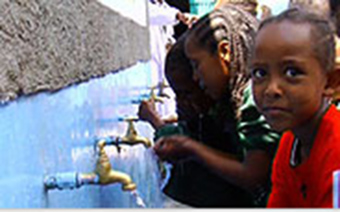
World Toilet Day (Figure 3.7) is dedicated to improving people’s access to, and proper use of, a toilet. It is a day to raise the public’s awareness of the importance of toilets in blocking faecal-oral disease transmission and the need for all people to have access to a toilet. World Toilet Day has been celebrated in Ethiopia every year on 19 November since 2012.
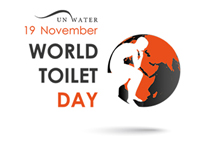
World Water Day (Figure 3.8) is marked on 22 March. Since 1993 it has been celebrated around the world, every year focusing on a different issue of water supply and sanitation.

In summary, the international initiatives and events that have been introduced and applied across many countries (including Ethiopia), have improved recognition of WASH among governments, decision makers, and practitioners. These events have raised public awareness and increased the commitment to take practical action at all levels, from families through to national government. In this way, the international and national initiatives have guided the formulation of the OWNP.
Summary of Study Session 3
In Study Session 3, you have learned that:
- The One WASH National Programme is the result of processes over many years during which the foundation was laid.
- A Sector-Wide Approach (SWAp) is a development concept where all significant sector investments are channelled towards the same objectives following a consistent strategy, guided by a consolidated investment plan. This has many advantages over the traditional project-based approach.
- Among the foundations for the development of the OWNP, the main documents are the Memorandum of Understanding (MoU) signed in 2006 and revised and signed again in 2012, and the WASH Implementation Framework (WIF).
- The WASH MoU is a formal working document that describes the roles and responsibilities of the signatory stakeholder ministries.
- The WASH Implementation Framework (WIF) is a guiding document for all WASH programme implementation across the country.
- The National WASH Inventory gives baseline data to provide comparison for assessing future changes in WASH provision.
- Several national and international initiatives have contributed to the formulation of the OWNP.
Self-Assessment Questions (SAQs) for Study Session 3
Now that you have completed this study session, you can assess how well you have achieved its Learning Outcomes by answering these questions.
SAQ 3.1 (tests Learning Outcome 3.1)
The table below shows information about two WASH projects:
| Project One | Project Two | |
|---|---|---|
| Administration costs for supplying funding | ETB 1,500 | ETB 6,000 |
| Cost of maintenance per household per year | Affordable | Unaffordable |
| Disabled access | No | Yes |
| Litres of clean water supplied daily per ETB 100 invested | 550 | 200 |
Look at the definitions in Section 3.1. They explain some of the main criteria used to assess the desirability of WASH projects. Think about what information in the table here is relevant to each of the criteria. Which of the projects above shows the highest:
- a.efficiency?
- b.equity?
- c.transaction cost?
- d.sustainability?
Answer
- a.Project One. It has a higher output (litres of water) for a given input (per ETB 100 invested)
- b.Project Two. It has disabled access.
- c.Project Two. It has higher administration costs for supplying the funding.
- d.Project One. It is more sustainable because the maintenance is affordable.
SAQ 3.2 (tests Learning Outcome 3.2)
Is the following statement true or false? Explain your answer.
The OWNP was developed because the project-based aid approach was very efficient and successful, and initiatives that adopted a sector-wide approach, like the WIF, made things worse.
Answer
False. The new development concept that shaped the OWNP is commonly known as a Sector-Wide Approach, which is sometimes shortened to SWAp. It is more successful, equitable and efficient than the project-based aid approach because all significant sector investments are channelled towards the same objectives and follow a consistent strategy that is guided by a consolidated investment plan. The OWNP was developed to build on the successes of sector-wide initiatives like the WIF.
SAQ 3.3 (tests Learning Outcomes 3.1 and 3.3)
Rewrite the paragraph below using terms from the list provided to fill the gaps.
accountability, baseline data, Memorandum of Understanding (MoU), Ministry of Finance and Economic Development (MoFED), National WASH Inventory (NWI), project-based aid approach, sector-wide approach, stakeholders, WASH Implementation Framework (WIF).
In 2003, an aid organisation from Europe sent workers to an Ethiopian village. The workers dug a well for the village, then went back to their home country. They did not coordinate the project with any government ministries. This is an example of a ……………… Because this is not a very efficient way of providing aid, in 2006 three government ministries signed the legally binding ………………, pledging that they would take a ……………… to WASH sector projects. This means that they agreed to work together to integrate the different elements of WASH, and involve all interested parties, which are known as ……………… A few years later some workers from the ……………… arrived in the village to record the WASH facilities. They needed to collect ……………… so that in the future the stakeholders would be able to tell if they had met their development targets. The workers found that the well had been contaminated from poor sanitation. Situations like this led to the creation of the ………………, so there were clearer plans for integrated WASH projects nationwide. These projects would require coordinated access to funding, so 2012 saw a new MoU, including the ……………… It outlined the areas of ……………… for each ministry, so everyone had definite responsibilities.
Answer
In 2003, an aid organisation from Europe sent workers to an Ethiopian village. The workers dug a well for the village, then went back to their home country. They did not coordinate the project with any government ministries. This is an example of a project-based aid approach. Because this is not a very efficient way of providing aid, in 2006 three government ministries signed the legally binding Memorandum of Understanding (MoU), pledging that they would take a sector-wide approach to WASH sector projects. This means that they agreed to work together to integrate the different elements of WASH, and involve all interested parties, which are known as stakeholders. A few years later some workers from the National WASH Inventory (NWI) arrived in the village to record the WASH facilities. They needed to collect baseline data so that in the future the stakeholders would be able to tell if they had met their development targets. The workers found that the well had been contaminated from poor sanitation. Situations like this led to the creation of the WASH Implementation Framework (WIF), so there were clearer plans for integrated WASH projects nationwide. These projects would require coordinated access to funding, so 2012 saw a new MoU, including the Ministry of Finance and Economic Development (MoFED). It outlined the areas of accountability for each ministry, so everyone had definite responsibilities.
SAQ 3.4 (tests Learning Outcome 3.4)
The United Nations WASH sector initiatives you have read about have a strong focus on equitable access to WASH facilities. Give an example of a national programme, other than the OWNP, that promotes equitable access and briefly explain how.
Answer
The Health Extension Programme (HEP) reflects equitable access as it brings sanitation and hygiene education to rural communities – especially where this has been lacking.